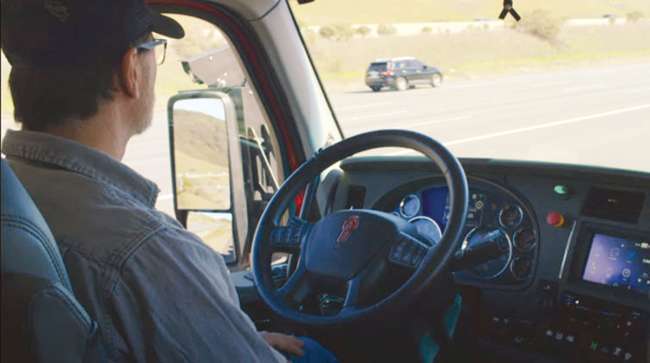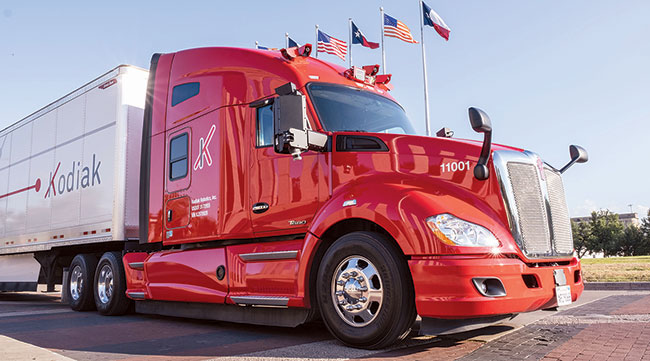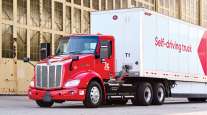Senior Reporter
Kodiak Robotics Expands Autonomous Truck Operations in Texas

[Stay on top of transportation news: Get TTNews in your inbox.]
SAN ANTONIO — Autonomous truck developer Kodiak Robotics this summer is expanding its routes, adding a Dallas-to-San Antonio run.
For much of the time along 273-mile Interstate 35, the Kenworth T680 truck is being driven in autonomous mode, with a safety driver in the left seat monitoring the truck’s performance.
The announcement of the expansion was made in San Antonio at American Trucking Associations Mid-Year Management conference, where one of the trucks was on display for attendees to see and talk with company officials about the emerging technology.
Mountain View, Calif.-based Kodiak Robotics currently runs trucks daily, for an undisclosed freight carrier, along heavily traveled I-45 between Houston and Dallas.

Goff
Daniel Goff, Kodiak’s head of policy, told Transport Topics that after having successfully tested the technology since July 2019, and with interest from trucking companies increasing, the decision was made to expand in July on the additional route.
“Our operations are based in the Dallas-Fort Worth area,” Goff said, “and we’ve been working with the Texas Department of Transportation and other stakeholders, including the governor’s office for 2½ years and they’ve been incredibly supportive.
RELATED: Kodiak Robotics chosen to receive CES 2021 Innovation Award
“We see from a commercial and technology perspective it is time to expand. We have learned a ton on Interstate 45, but when you add new highways, you learn new things, and we think that’s important for building our commercial relationships.”
Without being specific, Goff said on the Houston-to-Dallas trip the vehicle is operating on the highway in the autonomous mode “a good percentage of the time.”
“That means the vehicle can navigate everything it sees,” he said. “That includes heavy traffic, construction and everything the highway can throw at us.”
Goff said that earlier this year one of the trucks equipped with Kodiak Robotics autonomous technology completed two round trips in a row, covering more than 800 miles in autonomous mode.

(Kodiak Robotics)
Kodiak Robotics doesn’t build its own trucks. Rather, it works directly with fleets and original equipment manufacturers that are interested in using its onboard sensors, radar, cameras and computer processors to operate the truck with the safety driver monitoring the ride but letting the hardware and software do the work.
Goff said the Kodiak Robotic system can integrate new information about the road, whether it be construction or a detour, and incorporate it into the truck’s maps, which can be sent via over-the-air updates, allowing for a real-time response to road conditions.

Next-level technologies hold the potential to enhance safety and efficiency in transportation, but it takes a lot of work behind the scenes to advance these ideas from concept to reality. We talk with Christoph Mertz of the Robotics Institute at Carnegie Mellon and Huei Peng of the University of Michigan. Hear a snippet above, and get the full program by going to RoadSigns.TTNews.com.
Self-driving programs that are being developed by other companies use high-definition maps that script a particular stretch of road down to the last detail. Kodiak Robotics believes its system is superior because the cameras, sensors, and radar are always monitoring the road, and its maps can be updated continuously.
Goff said that as more trucking companies begin to use autonomous driving equipment highways will, in the long term, be made safer.
“There are certainly a lot of people who see the safety benefit and see it as critical,” he said. “We employ a lot of test drivers and that is very consistent among our drivers; during their career they’ve had that near-miss or an accident, and they really see the benefit of this potentially life-saving technology as well.
“We think in the next few years we’ll be able to build a very compelling case that we are safer than a human driver, and that’s going to be transformative.”
Want more news? Listen to today's daily briefing below or go here for more info:




